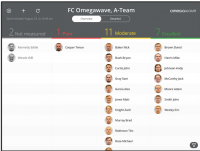The Omegawave can play a role in injury reduction in several ways:
1) to function optimally in speed/power activities you need the nervous to be in an optimal state. The OW tests both the autonomic nervous system (measuring heart rate variability) and the central nervous system (measuring low level electrical output of the brain). Speed and power activities (think sprinting, agility, jumping etc) require the nervous system to turn muscles on and off very rapidly. If this system is fatigued this ability is impaired which means performance suffers and injuries can occur. By monitoring neural fatigue you can reduce the training volume or completely alter the workout. For example, if you have 2 WRs showing poor readiness scores then you could have them on a pitch count during practice - limiting the numbers of reps they'd take that day. Heres a sample screen shot from the OW coach system
View attachment 930
In this sample, this athlete is 100% ready to do any endurance or strength training activity. He can tolerate a reduced volume of speed power work (meaning he could be on a rep count in practice). He will have a difficult time with coordination and skill activities. Every athlete has had bad practices where things just didn't go right - perhaps they would have tested in a similar manner?
2) By testing the whole team, coaches will have a better idea of the total work load that practices place on the players. It should help prevent coaches from running players into the ground - which leads to excessive fatigue and a higher potential for injury. You could produce a report for coaches showing who's ready for a higher work load that day, who should be watched for signs of fatigue, and who should be given a reduced role
View attachment 931
3) The system can show athletes what effect their diet/sleep/recovery habits have on the their bodies, hopefully enforcing better lifestyle choices/habits. Not getting enough sleep will reduce CNS output, poor nutrition can negatively effect HRV scores as can living a high stress lifestyle. Alcohol will also negatively effect HRV scores.
Hopefully this give you guys a small sample of what this system can do for our team. Training is all about giving the athletes what they need to get better, in the proper amounts, and at the proper time. This system can help the coaching staff, the S&C staff and the training staff monitor the athletes to ensure the team is being trained as optimally as possible. We all know injuries can absolutely wreck a team's season. Anything that we can do to prevent injuries and optimize performance is a huge plus.






